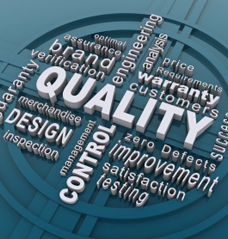 What are you doing to set standards for exceptional quality and safety in your company?
What are you doing to set standards for exceptional quality and safety in your company?
There are two common organizational flaws that come to mind when I think of quality and safety programs. The first is the company that goes out of its way to preach the importance of quality and safety, but does not back it up with an infrastructure that establishes metrics and systems to continuously improve. Second is the company that has an internal group of individuals trying to make a difference but does not have the management commitment to measure qualified metrics as a means of judging success. Where does your company lie between these two examples? Do you have quality and safety programs or are you living and breathing cross-functional continuous improvement initiatives that determine your company’s success?
Here Are 6 Success Tips to Make Quality & Safety Part of Your Company’s DNA
1: Have documented procedures and “Standard Work” for all processes.
Good quality processes start with documented procedures and standardized work instructions. If done well, they are brief, easy to read and taught to multiple employees. Good “Standard Work” is often pictorial in nature and can be summarized in single page print-outs. The same applies to all safety procedures. Employees need to be able to refer to these documents at their point of work whether in the office, on the shop floor, or in the field.
2: Consider hiring skilled professionals with backgrounds in Lean, Six Sigma and Quality Management.
Most organizations understand when they have poor quality, and they certainly know when there is a safety problem. But few understand the scientific tools used to correct and improve performance in both. The “science” of quality and safety has been developed for decades by professionals from some of the best companies in the world. An entire industry of quality experts commonly use tools such as Six Sigma to control their processes, or “Lean” – to reduce waste and non value-added steps in their daily work. Choosing the right tool depends on the type of problem an organization is having. A good Quality Manager is well schooled in several of these paradigms and chooses the right tool for the job – without over-applying any specific discipline.
3: Have key decision-makers develop a series of top-line metrics for measurement.
It is often said, “you can’t manage what you can’t measure.” All quality and safety processes require good metrics to baseline current performance, set targets for future improvement, and understand when things have changed. All metrics start with a good value statement – “What is the customer (both internal or external) willing to pay or give for the output of the process being affected?” Metrics – or measurements – allow the owners of processes to fully understand if they are delivering the value expected by the customer. All levels of an organization need at least 3-5 key metrics to monitor performance.
4: Develop a safety and quality mission statement and culture.
Every organization – large or small – needs to have a vision and mission if they want the organization to perform and succeed. In larger organizations, a formal, written statement of these values is often required, to ensure that all employees are reached with the message! But writing a mission statement and posting it on a conference room wall is not enough to build a great organizational culture – especially in Quality and Safety. All great companies must have its leadership “walk the talk” of quality and safety at all levels. Metrics, tools and accountability help build that culture - but good people make it come to life!
5: Recruit champions in each area of your business.
Promote your cause throughout the organization by training someone in each department to implement and influence continuous improvement activities in their area. These individuals will champion and lead by example as your message gets spread. Make sure that all members of your senior management team back this project and support their employee’s participation.
6: Share your results.
Create a monthly newsletter or email that reiterates your objectives for the company as well as gives accolades to those people and departments that are implementing continuous improvement actions. Use it as a vehicle to share ideas and results in layman’s terms while raising the profile of your cause throughout the company.
You don’t have to work in any particular department to measure quality or safety. You can and should be proactive about measuring your own results and the results of your team.
Special thanks to my friend and colleague Mike Heburn for helping to define these tips.
Written by Lisa Woods,
President ManagingAmericans.com